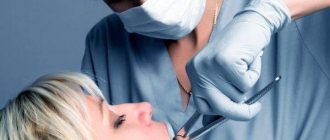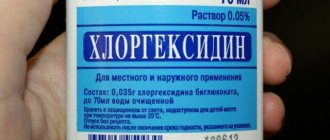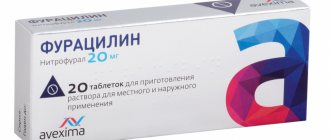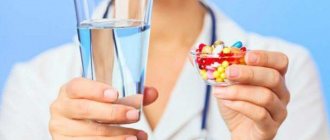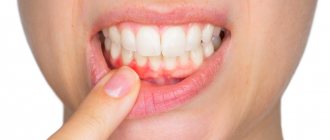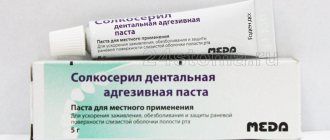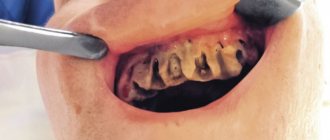Rinsing with chlorhexidine will help solve more than one oral problem.
Chlorhexidine is an antiseptic used in many areas of medicine. Due to its wide spectrum of action, it is especially popular in the treatment of oral diseases.
Dentists often prescribe this drug for the treatment of inflammatory processes of the gums. In order for treatment with chlorhexidine to have the desired effect, you need to know how to rinse your mouth with chlorhexidine for gum inflammation.
A complete overview of the useful product: scope, rules of use and main indications
Even simple tooth extraction inevitably leads to tissue trauma. Therefore, after the procedure, it is very important to follow the doctor’s recommendations to prevent infection of the open wound, inflammation of surrounding tissues and the development of other complications. One of the main aspects of prevention during the rehabilitation period is maintaining hygiene with regular antiseptic treatment of the oral cavity. For this purpose, specialists usually prescribe antibacterial solutions for rinses and mouth baths, for example, Chlorhexidine. Further in the article, read about the indications for use of the product, its pros and cons, precautions, as well as how to properly rinse your mouth with Chlorhexidine after tooth extraction.
How to use the product correctly
You can relieve inflammation of the gums by rinsing with Chlorhexidine or treating the mucous membranes with it. Swallowing the solution is highly not recommended, but if this does happen, it is not so scary for an adult body. Treatment of inflammatory processes in the oral cavity is carried out with a medicinal solution prepared from this drug, or a concentrated product.
"Chlorhexidine" for gum inflammation
Dilution of "Chlorhexidine"
When treating gum inflammation in adults, there is no need to dilute the solution; it is used in its pure form. But Chlorhexidine can also be prescribed to children over 7 years old, so for them the medicine must be diluted. This is done as follows: mix 1 part of the medicine and 2 parts of clean water. The amount of water must necessarily exceed the amount of the drug. Otherwise, the lining of the baby's mouth or throat may become damaged.
The drug can be diluted with water
Starting to rinse
For this purpose, a syringe is used, with which the solution is injected into the mouth. If you are treating a small child, make sure that the drug does not get into the stomach cavity. But if the child has swallowed a small amount of the solution, give him a lot of clean water to drink and offer 2-3 tablets of activated carbon.
Activated carbon
Rinse with a syringe in the bathroom, gently bending over the bathtub. This is necessary for normal pouring of the injected solution out. Failure to comply with this condition will lead to the fact that all the liquid will be inside, and this is extremely undesirable. When performing this procedure, be extremely careful and follow all recommendations. Otherwise, you can not only not cure the inflammation, but also harm the body even more.
A syringe is used to rinse
During pregnancy and breastfeeding
Dentists quite often recommend that pregnant patients rinse their mouths with Chlorhexidine. This is due, first of all, to the fact that the use of the drug will not cause rejection on the part of the expectant mother or fetus. Therefore, the product is actively used in dentistry already in the early stages of pregnancy.
In addition to rinsing the mouth to treat inflammation of the gums and throat diseases, during pregnancy the drug can be used for other purposes:
- washing the vaginal mucosa before various gynecological procedures;
- treatment of the inflammatory process in the vagina;
- treatment of infectious pathologies that can be sexually transmitted.
Use of the product during pregnancy
Regardless of the reason for using Chlorhexidine, all actions, especially during pregnancy, must be agreed with the attending physician. After all, the health of not only the mother, but also her unborn child is at stake.
"Chlorhexidine" - what is this drug and when is it indicated for use?
We are talking about one of the most effective and at the same time financially affordable drugs with an antibacterial effect. This is a disinfectant solution, the action of which is aimed at combating pathogenic microflora - fungal or bacterial etiology. The use of the product in dentistry provides high-quality antiseptic treatment of the mucous membrane and teeth during or after treatment of pathological conditions, with cuts and trauma to oral tissues, after tooth extraction, including complex extraction of wisdom teeth, as well as after any other surgical interventions. The drug is indicated for use at any age, including children and women during pregnancy, but only as prescribed by a doctor.
The solution is a clear, almost odorless liquid. The drug is based on the active substance – chlorhexidine bigluconate. Chlorhexidine is available in different forms: spray, solution or vaginal suppositories. At the same time, the spray and solution are also used to disinfect skin and medical instruments. The active component is effective against most pathogenic microorganisms, various viruses and yeasts.
The drug is produced in various forms
What to do if the drug is accidentally swallowed?
During the procedure, it is necessary to avoid getting Chlorhexidine into the stomach, but if this happens, there is no need to panic. The need to take any measures depends on the amount of the drug that enters the stomach. If the volume does not exceed one sip, you can do nothing, but at the same time carefully monitor how you feel.
- What medicine is put into the hole after tooth extraction?
If pain or cramping occurs in the abdomen, it is necessary to rinse the stomach with warm soda or saline solution, and then take any sorbent drug, for example:
- "Neosmectin";
- "Smectu";
- "Filtrum-sti";
- Activated carbon;
- "Polysorb".
Activated carbon
The same steps must be performed if the amount of medicine swallowed is more than 10 ml. If you feel unwell, have intestinal or stomach cramps or signs of intoxication, you should consult a doctor.
"Chlorhexidine" is one of the most famous and affordable antiseptics used in dental practice. It allows for disinfection of the oral cavity after surgery and prevents pathogenic bacteria from entering the socket of the extracted tooth. If you use Chlorhexidine according to the regimen prescribed by your doctor, you can avoid serious complications, for example, purulent-infectious lesions of the periosteum or alveolitis. During use, it is important to follow the precautions described in the official instructions for the drug.
Action and effectiveness of the solution after tooth extraction
After removing a tooth from its socket, an open wound remains in the mouth, which quickly fills with blood. Next, a blood clot forms in it, which becomes a kind of protective barrier that prevents the penetration of bacteria and the spread of infection through injured tissue. When this clot does not fit too tightly to the socket, is damaged, falls out, or does not appear at all, the risk of developing serious complications - alveolitis, which can subsequently lead to osteomyelitis of the jaw and osteonecrosis, that is, gradual necrosis of bone structures, increases significantly.
The photo shows a blood clot after tooth extraction
The main reason for the development of this complication is insufficient oral hygiene during the rehabilitation period. Harmful microorganisms penetrate the alveoli and provoke inflammatory processes. To prevent this, after tooth extraction, the doctor prescribes oral baths using Chlorhexidine. The drug provides high-quality disinfection of all surfaces in the oral cavity, prevents the development and spread of pathological processes of an inflammatory nature.
How to prevent gum disease
Any doctor will say with confidence that preventing a disease is much easier than curing it later. This also applies to gum inflammation. By regularly taking preventive measures, you can protect your body from unpleasant diseases. Below are step-by-step instructions to prevent the development of gum inflammation.
Table. Methods for preventing the inflammatory process.
- Rinse after tooth extraction with Chlorhexidine
| Steps, photo | Description of actions |
| Step one | Pay enough attention to brushing your teeth, doing this procedure at least twice a day. This will protect your teeth from plaque formation, as well as restore the microflora in the oral cavity. The duration of each procedure should not be less than 2 minutes. If possible, brush your teeth after every meal. Don't forget to clean your tongue and cheeks as this is where most bacteria accumulate. |
| Step two | Floss regularly. Many people neglect this wonderful and effective device, but regular flossing will remove plaque from hard-to-reach places where a regular toothbrush cannot reach. When flossing, you need to be careful not to damage the gum tissue. Otherwise, in addition to inflammation, you will need to treat the resulting bleeding of the gums. |
| Step three | Make sure you have enough vitamins in your diet. The body should receive a lot of folic acid, calcium and vitamin C. To do this, you should review the diet and, if necessary, adjust it slightly. Experienced nutritionists recommend adding more citrus fruits, lentils, beans, broccoli, grains, fish, dairy products, strawberries, melons and so on. All these products contain sufficient amounts of vitamins and minerals, which are so beneficial for teeth and gums. |
| Step four | Never use lemon juice or vinegar to rinse your mouth, even if your good friend who has previously performed this procedure advises it. This is an acid that, when in contact with tooth enamel, can destroy it. It is better to rinse the oral cavity with plain water. |
| Step five | It is known that severe stress or lack of sleep negatively affects the immune system, which ultimately leads to the development of many diseases. A weakened body is not able to resist various infections and viruses, so to strengthen it, try to be less nervous. You also need to devote enough time to sleep. Exercise, read books, or do other calming activities. But it is advisable to give up computer games, because it is the computer that causes stress the most. |
| Step six | Give up bad habits, in particular smoking. Nicotine negatively affects the health of the gums and the body as a whole. Therefore, in order to prevent the inflammation from developing again, you should still quit smoking. |
| Step seven | Visit your dentist's office at least twice a year, even if you don't have any problems with your teeth or gums. Preventive examinations will allow you to promptly identify pathology at an early stage of development and cure it as quickly as possible. Just start a new habit - visit the dentist regularly, and soon you will forget about problems with your oral cavity. |
Often, when the gums are inflamed, the patient experiences pain, so if pain occurs, immediately seek help from a doctor, because this may indicate the development of gum disease. After the examination, the dentist will prescribe appropriate therapy. Usually people themselves are to blame for gum problems, as they constantly ignore the rules of oral hygiene. But there is nothing difficult about brushing your teeth twice a day and changing your toothbrushes regularly.
Teeth cleaning
To prevent inflammation, you need to avoid food that is too cold or hot. Ice drinks, ice cream or hot soup - consuming all of these foods can trigger gum inflammation or the development of other oral pathologies. Try to give up the listed products at least for the period of gum recovery. Cold beer lovers should limit themselves to this drink until the inflammation is cured. You will find details on how wisdom teeth are removed on our website.
What are the advantages and disadvantages?
The drug is widely used in dental practice, and there is a whole list of good reasons for this. Experts cite the following points as the main advantages of “Chlorhexidine” for mouth rinse:
- helps in the fight against pathogenic microflora,
- has a wide range of antibacterial action,
- is inexpensive - about 15 rubles per bottle,
- provides a long-lasting antimicrobial effect – up to 4 hours,
- approved for use by children, as well as women during pregnancy and breastfeeding - in a minimum concentration.
The drug can be used by pregnant women.
But despite such an impressive list of advantages, the antiseptic has some disadvantages. The liquid has a bitter taste, which in some cases makes it difficult to use and provokes vomiting. The solution may be ineffective against powerful viral attacks (with the exception of herpes). After a course of using the drug, teeth may acquire a grayish tint. You need to stop rinsing so that the enamel returns to its original appearance.
Features of "Chlorhexidine"
When the drug comes into contact with a fungus or bacteria, the antiseptic properties of Chlorhexidine are activated, as a result of which the microorganism dies. The product can cope with any form of bacteria, but, unfortunately, it is powerless in the fight against viruses. The virus shell is quite dense, which is why the active components of the drug are unable to dissolve it.
"Chlorhexidine"
Among all the advantages of the medicine, it is worth noting its long-lasting effect, since “Chlorhexidine”, when rinsed, creates a protective film on the surface of the mucous membrane, which does not disappear for 4-5 hours. The drug can also be used after removal of the hole, as it is able to destroy harmful bacteria in the presence of blood. For this reason, dentists recommend taking Chlorhexidine after various dental procedures.
Chlorhexidine is available without a prescription
Video: Chlorhexidine, instructions
How to properly prepare a solution for rinsing and mouth baths
Now pharmacies sell solutions that are ready for use - in a concentration of 0.05%. It is recommended to use one tablespoon of the product to treat oral tissues.
There are also solutions on sale at a concentration of 0.20% - they must be diluted before use. To do this, take 2.5 ml of concentrate (the exact volume can be measured using a regular syringe) and dilute it in a liter of water. The substance should be thoroughly mixed. If a burning sensation occurs while rinsing, you need to add a little more water. It is important to follow the recommended proportions so as not to cause soft tissue burns.
Recommendations for the use of "Chlorhexidine" - instructions for use
Regarding how many times a day you can rinse your mouth with this product, you should immediately note that using it too often during the day risks causing irritation and even burns of the mucous membrane. If you overdo it with Chlorhexidine after tooth extraction, this can lead to the displacement of a blood clot and the development of related complications.
To ensure a therapeutic and prophylactic effect, it is enough to rinse your mouth twice a day - morning and evening. If bleeding gums occur, the frequency can be increased to three times a day, but no more. Rinsing the mouth should be carried out according to the following instructions:
- First, you should brush your teeth thoroughly,
- After about an hour, you need to rinse your mouth with boiled water at room temperature,
- Next, you should take a small amount of liquid into your mouth (about one tablespoon) and hold it a little on the side of the extracted tooth - 2-3 minutes,
- spit out the product and then do not rinse your mouth, eat or drink for at least an hour.
A tablespoon of product is enough for rinsing.
The duration of a standard preventive course is 1-2 weeks. When rinsing, it is important not to allow the product to enter the digestive tract, as this can cause irritation of the mucous membrane of the stomach and intestines. After using the product, it is not recommended to eat or drink for 1-1.5 hours, otherwise the effectiveness of the solution will decrease.
If you use the product for a long time, it can have the opposite effect - destroy beneficial flora and lead to the development of dysbacteriosis. This pathological condition is characterized by the appearance of bad breath, the formation of dense plaque on the mucous membrane and other symptoms. Most often, dysbiosis leads to the development of stomatitis - inflammation of the mucous membranes in the oral cavity.
Application in dentistry
Thanks to the active components that can destroy all pathogens in the patient’s mouth, it is difficult to do without this drug in dental practice. The main advantage of the solution is that it does not lose its medicinal properties even when pus is released from the wound.
Description of "Chlorhexidine"
For what purposes do dentists most often recommend Chlorhexidine:
- for treating hands before surgery;
- with severe inflammatory processes, including chronic periodontitis;
- ensuring sterility in the patient’s oral cavity, which is necessary for removing a diseased tooth. This allows you to prevent unpleasant consequences from occurring;
- treatment of various oral pathologies;
- local anesthesia for dental treatment. As a rule, it is used together with other medications;
- root canal cleaning.
Gum inflammation
On a note! Many toothpastes contain Chlorhexidine as an active ingredient. It is also used for rinsing in the treatment of various pathologies, such as gum disease.
Video: Chlorhexidine for stomatitis
Why you shouldn’t rinse your mouth after tooth extraction or how to do it correctly
We have found out how to properly dilute the solution and rinse your mouth with it, and now let’s move on to the question of whether it is possible to rinse the hole with it after tooth extraction. The thing is, after such a procedure, any antiseptic solutions can be used exclusively for oral baths. Rinsing and anything that can create a vacuum in the oral cavity is strictly contraindicated. Otherwise, the risk of damage to the blood clot in the socket will seriously increase, and this is fraught with the development of a whole series of complications.
“I always have chlorhexidine in my medicine cabinet - where would I be without it! By the way, it is better to keep it in the refrigerator. In my opinion, this is an excellent product and at the same time so cheap. I use it to treat my youngest son’s wounds if he gets scratched somewhere, and I rinse his mouth when his gums become inflamed...”
EkaterinaT., from correspondence on the forum www.32top.ru
It is important to follow the instructions for use.
To carry out antiseptic treatment, just take a small amount of the product into your mouth and hold it on the side of the causative area. The liquid should then be spat out. There is no need to rinse your mouth with water after the procedure.
Can children rinse their mouths with Chlorhexidine?
Tooth extraction may also be required in childhood. Typically, this measure is required when baby teeth are loose, but in case of severe carious lesions, molars may also need to be removed. Preventive treatment with antiseptics in childhood is especially necessary. This is due to several factors:
- insufficient activity of the immune system to suppress the growth of pathogenic microorganisms;
- poor hand hygiene and non-compliance with sanitary standards;
- increased sensitivity of the gums and soft tissues surrounding the tooth to the effects of pathogenic bacteria and inflammatory processes.
Can children rinse their mouths with Chlorhexidine?
If necessary, Chlorhexidine can be used in childhood, but the rules of use will differ from the preventive treatment of adult patients. For children, it is recommended to dilute the drug with boiled water in a ratio of 2:1 (2 parts Chlorhexidine - 1 part water). You should rinse your mouth strictly under adult supervision and only if the child knows how to spit out the product and does not swallow it.
The number of procedures is also slightly reduced. The maximum permissible number of rinses in childhood is 2 times a day. The course of prevention depends on the age of the child. Approximate norms are presented in the table below, but they may vary depending on the condition of the oral cavity, the complexity of removal and other individual characteristics of the child.
Treatment of a child with the drug is allowed
Table. The duration of the course of use depends on the age of the child.
| Child's age | Course of use after tooth extraction |
| 2-5 years | 3 days |
| 5-8 years | 5 days |
| 8-14 years | 7 days |
Contraindications and side effects
The drug has virtually no contraindications. The only exceptions are various groups of dermatitis. However, in rare cases, intolerance to the active substance and allergic reactions are detected - in less than 1%.
As for adverse reactions, they also appear only in extremely rare cases. Sometimes there is drying of the mucous membranes, slight plucking, burning and itching. If these manifestations are of moderate intensity, you can try adding a little more water to the solution. It should be noted that most patients tolerate Chlorhexidine well.
During pregnancy and breastfeeding
"Chlorhexidine" is indicated for use by women during pregnancy and breastfeeding, but only if the patient does not have open wounds or cuts in her mouth. The drug has a superficial effect and is not absorbed into the blood or breast milk.
When breastfeeding, the drug can also be used
For small patients, the preferred form is a spray - it does not require rinsing skills to use. With its help, you can easily treat any areas of the oral mucosa. However, Chlorhexidine should not be used on children under 3 years of age, in particular for irrigating the tonsils. In both cases, the maximum permissible course duration should not exceed 10 days, and the use of the drug must be agreed with a doctor.
Are there any contraindications
Despite all its beneficial qualities, Chlorhexidine has several contraindications:
- the instructions state that the drug is not intended for children under 7 years of age, because it is dangerous to the body if swallowed;
- people suffering from high sensitivity of the oral mucosa or allergies to certain components of the drug are also not recommended to use it;
- The solution cannot be used together with other iodine-based drugs;
- Regular use of Chlorhexidine as a mouth rinse can cause the patient's tooth enamel to darken. Long-term use of the drug contributes to disruption of the microflora of the oral cavity.
Chlorhexidine has contraindications
For safety reasons, it is still better to avoid using Chlorhexidine if it is contraindicated for you. Before use, be sure to consult a doctor.
- How long does it take for drugs to leave the body?
What can be replaced - alternative options
"Chlogexidine" belongs to the class of inexpensive drugs, but it may not always be on hand or in the assortment of the pharmacy. Among analogues with identical active ingredients in their composition, experts identify the following medicines:
- “Instillagel” - along with chlorhexidine digluconate, the composition includes lidocaine, hydrochloride and auxiliary components. It has a pronounced bactericidal effect and gives an analgesic effect; it is often used as a local anesthetic during endoscopic examinations,
- "Baktosin" - the composition also contains a solution of cetrimide. The drug is available in liquid form and is prescribed as part of the treatment of purulent skin infections, as well as pathologies of the oral cavity and bacterial urological diseases,
- “Citeal” also contains chlorocresol and hexamidine diisothionate. Used for antiseptic treatment of skin and mucous membranes for bacterial and fungal infections.
There are other solutions, but they will already contain another active component. One of the most popular drugs belonging to this category is the drug Miramistin.
"Chlorhexidine" or "Miramistin" - what to choose
Another popular means for antiseptic treatment of oral tissues is the Miramistin solution. It is based on another active component - benzyldimethyl ammonium chloride monohydrate, but the essence of the action of the product and the degree of its effectiveness are approximately identical. The drug is also prescribed for the prevention and control of viral, bacterial and fungal infections.
Which drug is better to choose?
When answering the question of what to choose: “Miramistin” or “Chlorhexidine”, it is necessary to explain that both products are characterized by a similar effect and scope of application, but the latter has existed for a long time and during this time has managed to prove itself well. On the other hand, Miramistin is a relatively new remedy, no less effective and safe. If we talk about the differences between drugs from each other, then we can highlight only a few nuances:
- After shaking the bottle, Miramistin forms a dense foam that does not settle for a long time. In the case of Chlorhexidine, the opposite is true - the foam is liquid and settles quickly,
- "Chlorhexidine" is ideal for external use, but if it comes into contact with the mucous membrane, it can cause a noticeable burning sensation. "Miramistin" does not give such a reaction,
- Too long or frequent use of Chlorhexidine can lead to a change in the color of the enamel, while its competitor acts more gently and does not affect the appearance of the teeth.
When choosing the most suitable product for your specific case, it is better to trust an experienced specialist. Only a doctor, based on the individual characteristics of your particular clinical picture, will be able to choose the most effective drug.
